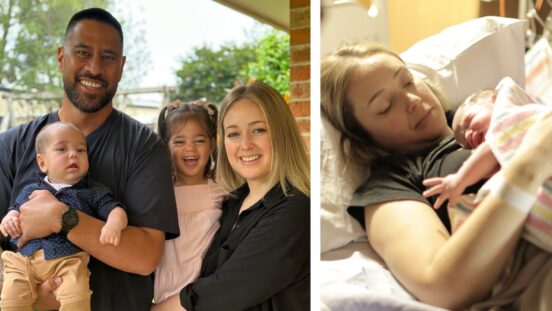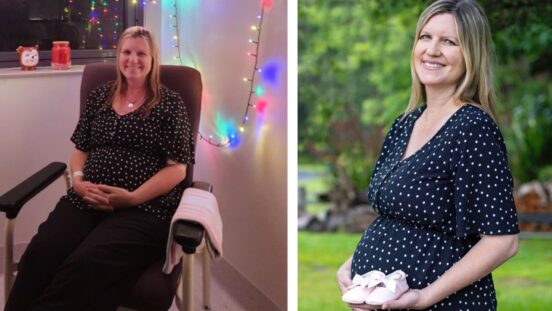Real life: 5-year-old Lucy’s bruising turned out to be cancer

When Lucy’s parents arranged a simple checkup for an unexplained bruise, they had no idea that the news would be so devastating.
By Kirsty Veliades – Lucy’s mum
In January 2021, Lucy was just like every other 5.5-year-old girl preparing to start school when two bruises appeared above her eyes. A set of similar bruises had appeared late the previous year, and while there were no other obvious signs that something may be wrong, we decided that it was best to get them checked by a doctor, just to be safe.
“We knew something must be wrong…”
While not overly concerned, the doctor decided to order a blood test. On Friday afternoon Lucy reluctantly had her blood drawn, and by 11pm that evening I had received a call from the pathology lab checking on Lucy as her haemoglobin levels were unusually low. While she was fine to stay home that evening, the family headed to RCH in Melbourne the following day on doctors orders for more tests.
While we knew something must be wrong, we never imagined that it would end in a cancer diagnosis. Lucy was admitted to the ward on Saturday evening and by Monday morning we were given the devastating diagnosis of Stage 4, high-risk Neuroblastoma. A cancer we had never heard of until that day. A quick google very quickly leads you to the statistic that the over all survival rate for Neuroblastoma is just 50%.

A 50% survival rate
Further tests and scans in the following days discovered that the cancer was more widespread than initially thought with a large tumour originating from the adrenal gland taking over her chest and wrapping itself around major organs including her heart and vena cava. There was also widespread metastatic disease through all the bones in her body and in Lucy’s bone marrow.
On the day that Lucy should have been attending her first day of Prep with her friends, she was instead undergoing her first round of chemotherapy and recovering from multiple surgeries including ovary preservation, Hickman insertion and a bone marrow biopsy in previous days.
We were given a 14-month plan of 5 rounds of chemotherapy, surgery, 2 rounds of high-dose chemo and stem cell rescue, 12 days of radiation and 6 rounds of immunotherapy – along with a warning that the treatment timeline was very likely to blow out due to complications and unplanned hospital admissions.

Treatment impacts the whole family
The lives of our whole family ground to a halt over those days as we tried to process how we would manage treatment, work (because the bills still need paying despite all of this) and keeping life moving for our 8-year-old son Hunter.
But there was no option than to accept what was in front of us, do the best we could with the support of our family and friends around us and hope that the treatment would work.
The first 5 months of treatment were hard on Lucy, she went from feeling totally fine to being extremely unwell due to the chemotherapy. She lost all of her long hair, lost weight and had a nose tube in most of the time. But through it all she remained her positive, vibrant, determined self, attending school every opportunity she could, sometimes for just one day between treatment rounds.
The 8-hour surgery to remove the remaining tumour following the first 4 rounds of chemo resulted in Lucy being admitted to ICU for 3 nights, but the news was good. They were confident they had gotten all of the tumour and she was now cancer free.

Being cancer free did not mean that treatment ended
Following surgery there was an additional round of chemotherapy before round one of high dose chemo, followed by a stem cell rescue. This process effectively involved wiping out all of Lucy’s bone marrow, and therefor immune system, from the body before infusing her own clean stem cells back into her body to ‘’rescue’’ the immune system. We were warned that this round of treatment would be extremely tough on Lucy and that she would become extremely unwell. Though nothing could have prepared us for the following weeks where Lucy was diagnosed with VOD (Veno-occlusive disease) blocking the blood vessels to the liver and causing fluid retention to build up in her body. Respiratory distress caused by the VOD resulted in another 3-night ICU stay with Lucy intubated for the first night.
After 6 long weeks Lucy was finally discharged from the hospital and we were given the news that she would not be undergoing the second, planned, high-dose chemo and stem cell rescue as they were concerned that she may not survive it. This news was met with mixed emotions, of relief that Lucy would not have to endure another round of this brutal, high-risk treatment, and of concern that changing the treatment plan could reduce her chances of beating cancer once and for all.

Remission!
The following 8 months of treatment involving radiation therapy and immunotherapy, allowed more time at home between admissions fortunately as it also coincided with Melbourne COVID-19 lockdowns, where only one parent at a time was permitted in the hospital, with no visits from siblings, family or friends. Having Lucy rushed to ICU for the third time as her blood pressure plummeted and knowing that I could have no one to support me, was yet another challenging time.
Luckily the last few months of treatment were less traumatic and in March 2022, following end of treatment scans, we were given the amazing news that Lucy was officially in remission!
Now 19 months later we are fortunate that Lucy is living a pretty normal life. She has been diagnosed with high-frequency hearing loss but over all she is doing really well, attending school, playing netball and attending gymnastics. Things we would never have thought possible 2 years ago.
But the threat of relapse never really leaves your mind with approximately half of kids who achieve remission having the disease return in coming months and years. And for those that don’t, the chance of post treatment side effects, including infertility, heart, kidney and liver issues, continue for their whole lives.

“We consider ourselves one of the lucky families…”
Despite everything she has gone through we consider ourselves one of the lucky families, as we have Lucy here. Many kids each year diagnosed with Neuroblastoma don’t survive, either because of the cancer, or because of the devastating effects of the treatments on their bodies.
That’s why our family is participating in the Run2Cure. Lucy’s father Nick is an avid runner and having attended the Sydney event earlier this year as a family, we are excited to have our family and friends join us in Melbourne to raise much needed funds for Neuroblastoma Australia. These funds help support research into less harsh treatment options and to hopefully one day find a cure for this terrible disease. There may be ‘’just’’ 40 kids a year diagnosed with Neuroblastoma in Australia, but when one of those kids is yours, statistics don’t matter.
You can sign up to run or walk in the Melbourne Run2Cure event at Caribbean Gardens on 12th November. There are 3km, 5km and 10km distances and even a 1km option for little kids.
And if you can’t attend on the day you can donate here to support our family’s cause, or by donating here.




